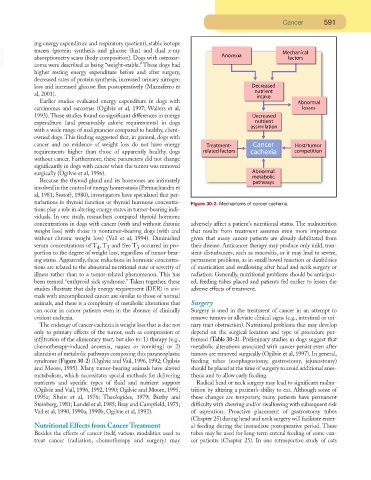Page 570 - Small Animal Clinical Nutrition 5th Edition
P. 570
Cancer 591
ing energy expenditure and respiratory quotient), stable isotope
VetBooks.ir tracers (protein synthesis and glucose flux) and dual x-ray
absorptiometry scans (body composition). Dogs with osteosar-
coma were described as being “weight-stable.” These dogs had
higher resting energy expenditure before and after surgery,
decreased rates of protein synthesis, increased urinary nitrogen
loss and increased glucose flux postoperatively (Mazzaferro et
al, 2001).
Earlier studies evaluated energy expenditure in dogs with
carcinomas and sarcomas (Ogilvie et al, 1997; Walters et al,
1993). These studies found no significant differences in energy
expenditure (and presumably caloric requirements) in dogs
with a wide range of malignancies compared to healthy, client-
owned dogs. This finding suggested that, in general, dogs with
cancer and no evidence of weight loss do not have energy
requirements higher than those of apparently healthy dogs
without cancer. Furthermore, these parameters did not change
significantly in dogs with cancer when the tumor was removed
surgically (Ogilvie et al, 1996).
Because the thyroid gland and its hormones are intimately
involved in the control of energy homeostasis (Premachandra et
al, 1981; Sestoft, 1980), investigators have speculated that per-
turbations in thyroid function or thyroid hormone concentra- Figure 30-2. Mechanisms of cancer cachexia.
tions play a role in altering energy states in tumor-bearing indi-
viduals. In one study, researchers compared thyroid hormone
concentrations in dogs with cancer (with and without chronic adversely affect a patient’s nutritional status. The malnutrition
weight loss) with those in nontumor-bearing dogs (with and that results from treatment assumes even more importance
without chronic weight loss) (Vail et al, 1994). Diminished given that many cancer patients are already debilitated from
serum concentrations of T , T and free T occurred in pro- their disease. Anticancer therapy may produce only mild, tran-
4
3
3
portion to the degree of weight loss, regardless of tumor-bear- sient disturbances, such as mucositis, or it may lead to severe,
ing status. Apparently, these reductions in hormone concentra- permanent problems, as in small bowel resection or disabilities
tions are related to the abnormal nutritional state or severity of of mastication and swallowing after head and neck surgery or
illness rather than to a tumor-related phenomenon. This has radiation. Generally, nutritional problems should be anticipat-
been termed “euthyroid sick syndrome.” Taken together, these ed, feeding tubes placed and patients fed earlier to lessen the
studies illustrate that daily energy requirement (DER) in ani- adverse effects of treatment.
mals with uncomplicated cancer are similar to those of normal
animals, and there is a complexity of metabolic alterations that Surgery
can occur in cancer patients even in the absence of clinically Surgery is used in the treatment of cancer in an attempt to
evident cachexia. remove tumors or alleviate clinical signs (e.g., intestinal or uri-
The endstage of cancer cachexia is weight loss that is due not nary tract obstruction). Nutritional problems that may develop
only to primary effects of the tumor, such as compression or depend on the surgical location and type of procedure per-
infiltration of the alimentary tract, but also to: 1) therapy (e.g., formed (Table 30-2). Preliminary studies in dogs suggest that
chemotherapy-induced anorexia, nausea or vomiting) or 2) metabolic alterations associated with cancer persist even after
alteration of metabolic pathways composing this paraneoplastic tumors are removed surgically (Ogilvie et al, 1997). In general,
syndrome (Figure 30-2) (Ogilvie and Vail, 1996, 1992; Ogilvie feeding tubes (esophagostomy, gastrostomy, jejunostomy)
and Moore, 1995). Many tumor-bearing animals have altered should be placed at the time of surgery to avoid additional anes-
metabolism, which necessitates special methods for delivering thesia and to allow early feeding.
nutrients and specific types of fluid and nutrient support Radical head or neck surgery may lead to significant malnu-
(Ogilvie and Vail, 1996, 1992, 1990; Ogilvie and Moore, 1995, trition by altering a patient’s ability to eat. Although some of
1995a; Shein et al, 1976; Theologides, 1979; Buzby and these changes are temporary, many patients have permanent
Steinberg, 1981; Landel et al, 1985; Bray and Campfield, 1975; difficulty with chewing and/or swallowing with subsequent risk
Vail et al, 1990, 1990a, 1990b; Ogilvie et al, 1992). of aspiration. Proactive placement of gastrostomy tubes
(Chapter 25) during head and neck surgery will facilitate enter-
Nutritional Effects from Cancer Treatment al feeding during the immediate postoperative period. These
Besides the effects of cancer itself, various modalities used to tubes may be used for long-term enteral feeding of some can-
treat cancer (radiation, chemotherapy and surgery) may cer patients (Chapter 25). In one retrospective study of cats

